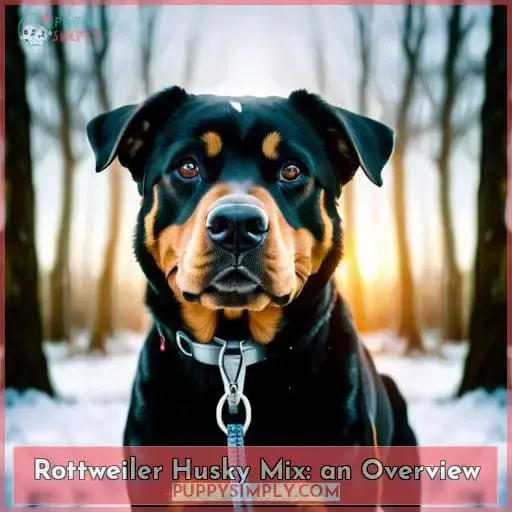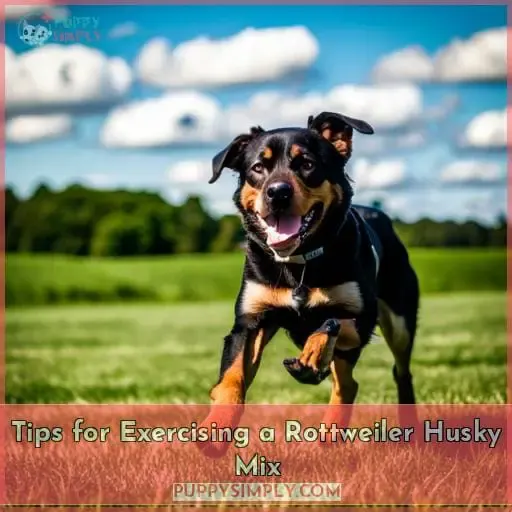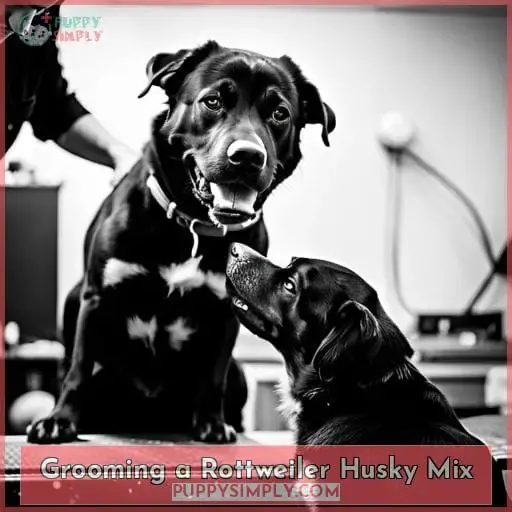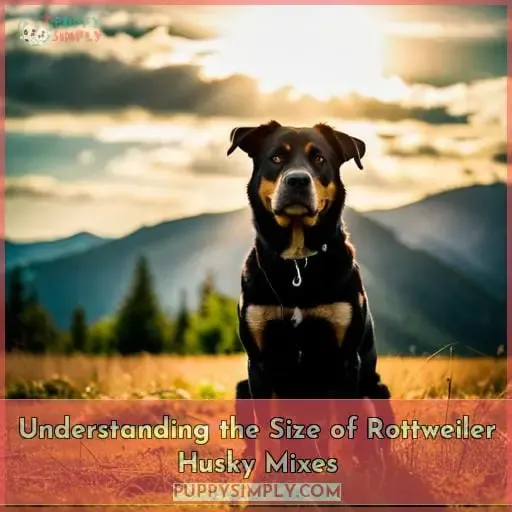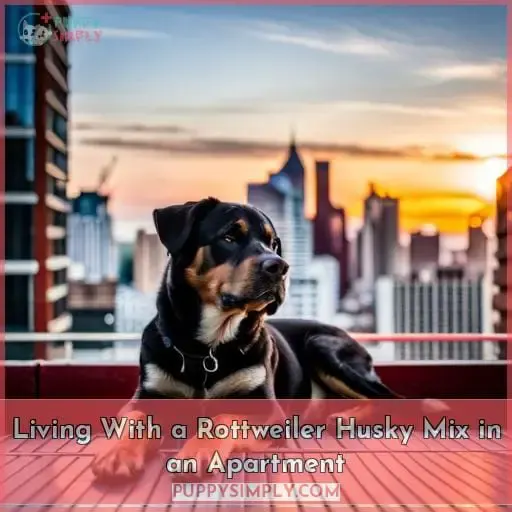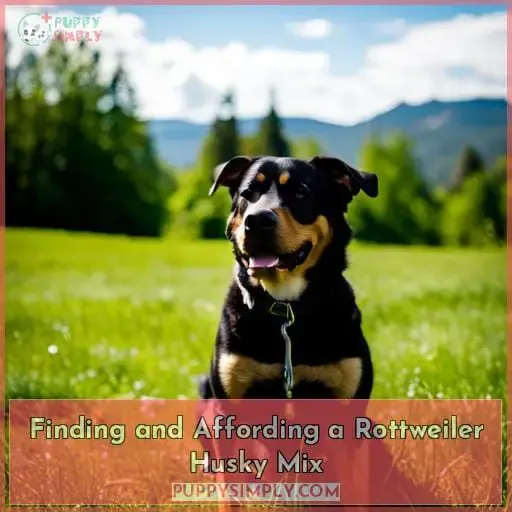This site is supported by our readers. We may earn a commission, at no cost to you, if you purchase through links.
 Do you have your heart set on a Rottweiler Husky mix? This unique and rare breed is growing in popularity, but it’s important to understand what you’re getting into before bringing one home. The Rottweiler has been used for centuries as a guard dog, and the Siberian Husky was bred to pull sleds.
Do you have your heart set on a Rottweiler Husky mix? This unique and rare breed is growing in popularity, but it’s important to understand what you’re getting into before bringing one home. The Rottweiler has been used for centuries as a guard dog, and the Siberian Husky was bred to pull sleds.
In this article, we’ll take an in-depth look at the size, temperament, and exercise requirements of owning a Rottsky. We’ll discuss their life expectancy and compatibility with children or living conditions like apartments.
Additionally, we’ll explore tips for exercising them properly and discuss the grooming needs that come with having such thick coats.
Furthermore, we’ll cover topics like growth stages associated with their size variations.
Table Of Contents
- Key Takeaways
- Rottweiler Husky Mix: an Overview
- Is a Rottweiler Husky Mix Right for You?
- Tips for Exercising a Rottweiler Husky Mix
- Grooming a Rottweiler Husky Mix
- Understanding the Size of Rottweiler Husky Mixes
- Living With a Rottweiler Husky Mix in an Apartment
- Finding and Affording a Rottweiler Husky Mix
- Conclusion
Key Takeaways
- The Rottweiler Husky mix is a unique and rare breed that combines the traits of both the Rottweiler and the Siberian Husky.
- They require regular grooming and exercise to maintain a healthy coat and prevent behavioral issues.
- Proper training and socialization are crucial for them to get along well with other dogs and children.
- They are loyal, protective, and intelligent, but they may be suspicious of strangers and experience separation anxiety.
Rottweiler Husky Mix: an Overview
Are you considering a Rottweiler Husky mix? This unique breed is a hybrid of the Rottweiler and Siberian Husky, combining their respective temperaments and appearances.
With an average lifespan of 9-13 years, combined with sizes ranging from 40 to 110 pounds and heights between 20-26 inches, these dogs are sure to make great companions for those looking for something different!
They require plenty of exercise as well as mental stimulation in order to stay happy and healthy.
Lifespan and Size
You might be surprised to learn that the Rottweiler Husky mix can have a lifespan of up to 13 years and reach heights of 26 inches! On average, they live 9-13 years and weigh 40-110 pounds. The size is determined by genetics from both parents, with males usually being larger than females.
Their growth stages consist of puppyhood, adolescence, adulthood, and senior age, all of which play a part in their life expectancy.
Not only do Rottskies come in different sizes, but they also have different coat types as well.
Temperament and Training
It’s important to understand the temperament and training of a Rottweiler Husky mix to ensure they fit into your lifestyle. Rottskies generally have an alert, protective, and calm temperament. They can be suspicious of strangers but friendly with their family members and other dogs when properly socialized.
Training should be firm yet fair as these pups are independent thinkers who learn quickly! Exercise is essential for them. They need both physical activity, such as walks or runs, and mental stimulation, like playtime or puzzle toys, provided daily.
Obedience classes may also help improve their behavior around people and other animals if needed.
Exercise and Grooming Requirements
Exercising and grooming your Rottsky is essential to keep this active breed happy and healthy.
Exercise recommendations include 1-2 hours of daily activity with plenty of mental stimulation activities, such as obedience training or leash walking.
Grooming techniques should involve regular brushing to manage coat shedding, as well as nail trimming and occasional baths depending on the size variation between dogs.
Mental stimulation tips are critical for keeping them engaged while providing necessary physical exercise needs. This helps prevent boredom-related behavioral issues associated with Rottweilers & Huskies.
Properly caring for these magnificent creatures requires dedication but results in a loyal companion that will bring joy into your life!
Is a Rottweiler Husky Mix Right for You?
Are you considering adding a Rottweiler Husky mix (Rottsky) to your family? Whether it’s the striking appearance, loyalty, or protectiveness of this crossbreed that has attracted you, it is important to consider if a Rottsky is suitable for your lifestyle.
Compatibility with children and suitability for first-time dog owners, as well as apartment living, should be taken into account before making the decision on whether or not this breed would fit best in your home.
Compatibility With Children
Although Rottskys can be protective of their family, proper socialization and training is necessary to ensure they are comfortable with children. With the right environment and activities, these intelligent dogs can become child-friendly pets.
Playtime activities should include supervised interactions between Rottsky and kids to help build a bond between them. Introducing your pup gradually with patience will also make it easier for them to get used to new people or environments.
New owners must also take extra safety measures when introducing their pet around small children, as this breed tends towards independence. This independence could lead to unexpected behavior during unfamiliar situations, such as rough play from young ones who may not understand dog body language yet.
Despite being independent thinkers, Rottweiler Husky mixes tend to be compassionate pets that form strong bonds with their families.
Suitability for First-Time Dog Owners
Given their independent thinking and stubbornness, a Rottweiler Husky mix may not be the best choice for first-time dog owners. Training challenges can arise due to their intelligence and strong will. Socialization is key in order to prevent behavioral issues, while exercise requirements should also be taken into account as they need 1-2 hours of activity per day.
Grooming needs are high with medium-length coats that require regular brushing, bathing, and nail clipping. It’s important to evaluate temperament before deciding on this breed – research both parents’ backgrounds prior to purchasing or adoption if possible! Consider the Rottsky’s health risks such as hip dysplasia and osteosarcoma too; buy from responsible breeders who screen for these diseases in parent dogs.
With its unique history of being bred by ancient Romans as well as Siberian Chukchi people centuries ago, this hybrid has an intriguing appearance that superficially resembles one parent more than another but ultimately, it comes down to genetics! Costly vet bills can quickly add up given the Rottsky’s large size, so ensure you have done your research thoroughly beforehand.
Apartment Living
Due to their size and energy levels, Rottskies aren’t ideal for apartment living – they’d much rather have the space to run around. To meet exercise needs in an apartment setting, owners need a plan that includes walks plus plenty of playtime with interactive toys or games like fetch.
Barking can be managed through consistent training; however, there may still be potential challenges due to the independent thinking of breeds like Husky. It is recommended to buy from reputable breeders or explore adoption options when looking for a Rottweiler Husky mix suitable for your lifestyle.
If you live in an apartment full-time and don’t think you’ll meet this pup’s needs properly, it’s worth considering other breeds.
Tips for Exercising a Rottweiler Husky Mix
Owning a Rottweiler Husky Mix is not for the faint of heart, as they require plenty of exercise and mental stimulation to stay healthy and happy. To ensure your Rottsky stays fit and entertained, it’s important to provide them with regular physical activity as well as various activities that will enrich their lives.
Exercise Needs and Recommendations
You should be prepared to provide plenty of exercise for your Rottweiler Husky pup, as they require regular physical and mental stimulation. Exercise routines can include daily walks, hikes, or jogs in the park. You can also engage them in swimming activities or playtime with toys like frisbees.
Mental stimulation is important too. Try training sessions using treats and fun commands to keep them stimulated.
If you have a physically active family that loves spending time outdoors, then this rare mix could be the perfect match for you! The key is remembering their unique exercise needs. Make sure they get enough activity, but don’t overdo it. These dogs were bred from sled dog ancestry and need rest days just like any other breed.
Mental Stimulation and Enrichment
It’s time to give your pup some mental exercise – because, let’s face it, they can get pretty bored! Rottweiler Husky mixes have the intelligence of both breeds and require training techniques such as positive reinforcement and cognitive activities.
Enrichment activities like puzzle toys are a great way to keep them engaged while providing essential mental stimulation. Additionally, breed recognition games help with recall commands and provide much-needed socialization for these protective dogs.
Finally, agility courses or activity companions offer physical exercises that also challenge their minds, making them ideal companions for any level of adventure-seeker.
Activities and Games for Rottweiler Husky Mixes
Bring out your pup’s inner athlete with activities and games designed to keep them mentally stimulated and physically fit! Get their energy levels up by playing outdoor games, such as fetch or tug-of-war.
For mental enrichment, introduce puzzle toys that require problem-solving skills. To boost obedience training, practice basic commands like sit or stay in a variety of settings.
Hide & seek is another popular game among Rottweiler Husky mixes. They love trying to find their owners around the house! Don’t forget that regular walks are essential for keeping this breed healthy too.
Grooming a Rottweiler Husky Mix
It’s important to understand the grooming needs of a Rottweiler Husky mix before bringing one into your home. With its medium-length coat, this crossbreed requires regular brushing and bathing, as well as nail trimming and other basic grooming tasks.
Coat Type and Shedding
The Rottsky’s coat type and shedding level can vary depending on the dominant gene, but they typically have a long and thick coat like Huskies. Regular grooming is essential to keep their coats healthy and prevent allergies in your home.
To maintain their beautiful fur, consider brushing them daily or every other day during seasonal shedding.
Brushing and Bathing
You’ll need to brush your Rottsky regularly to keep their coat in good condition and reduce shedding. Brushing also helps prevent mats from forming, which can be uncomfortable for them. A slicker brush is a great tool for brushing out tangles or dirt that may have gotten caught in the fur, while a pin brush works well with longer coats.
For best results, you should bathe your Rottsky at least every two months with a shampoo specifically designed for dogs. Make sure it’s mild enough not to irritate their skin but still effective at cleaning! If you notice any redness around the eyes or ears after bathing them, rinse off all soap residue thoroughly as these areas are more sensitive than other parts of their body.
Lastly, try using grooming wipes if necessary. They’re an easy way of keeping your pup clean between baths!
Nail Trimming and Other Grooming Needs
Regularly trimming your pup’s nails and providing other grooming needs will help keep them looking, feeling, and smelling their best. Nail trimming techniques should be done every two to four weeks with a pet-safe nail trimmer or grinder.
For coat care tips, brushing is key for Rottskies as they can shed heavily twice per year. Use a slicker brush at least once weekly to remove dead hair from the undercoat.
Ear cleaning methods are important too. Use an ear cleaner specifically designed for dogs on cotton balls and use gentle swipes inside the ears only when necessary.
Dental hygiene practices, such as daily teeth brushing, help prevent plaque buildup, which in turn reduces bad breath odor in your pup’s mouth!
Paw pad maintenance is also crucial. Check paw pads after walks for cuts or cracks that may require inspection by a vet.
Health checks should always be done routinely to ensure the overall well-being of your Rottsky friend!
Understanding the Size of Rottweiler Husky Mixes
Are you curious about the size of a Rottweiler Husky mix? This lovable breed can range in size depending on several factors, including genetics, nutrition, and exercise. On average, they weigh 40-110 pounds and grow 20-26 inches tall as adults. To understand their growth better, it’s important to know what stages a Rottsky goes through from puppyhood to adulthood.
Average Height and Weight
Knowing the average height and weight of a Rottweiler Husky mix can help you visualize how big your pup may get. Males typically grow 22-26 inches tall and weigh 50-110 pounds, while females reach 20-25 inches tall and 90 pounds.
Size variations are often due to genetics, but growing stages play an important role too. Puppies usually gain most of their size during their first year before reaching adulthood at around 18 months old.
Factors like diet, exercise levels, and gender differences also affect growth rates.
It’s worth noting that certain eye colors can be linked with size in Rottsky pups; however, this is not always reliable or ethical, so it’s best avoided when buying a puppy!
Factors Affecting Size Variations
Factors such as the dominant genes, diet, and exercise can affect how big your Rottsky gets. Genetic influences play a large part in determining size. If one parent is larger than the other, then their traits will likely be more prominent in the pup.
Environmental factors like living space also come into play. An outdoor environment with plenty of room to run and explore will encourage healthy growth compared to living exclusively indoors where physical activity levels are lower.
Exercise levels should be kept high for optimal growth rate, while nutritional considerations are important too.
Growth and Development Stages
Gaining an understanding of the growth and development stages of a Rottweiler Husky mix can help you prepare for their size variations. From birth to adulthood, your Rottsky will need proper nutrition, socialization, training, and exercise.
As they grow up, it’s important to provide nutritional needs specific to their age group – puppy food in the first year or two before transitioning them onto adult diets. It’s also essential that they receive lots of positive attention during early socialization so that they mature into well-adjusted dogs with good behavior around people and other animals alike.
Proper training is key too; methods like clicker training are highly recommended as this breed may be more independent than most other breeds out there! Lastly, but importantly, common health issues such as hip dysplasia should be kept in mind when considering a Rottweiler Husky mix pup – regular checkups at the vet will ensure any problems are caught early on.
Living With a Rottweiler Husky Mix in an Apartment
If you’re living with a Rottweiler Husky mix in an apartment, you’ll need to consider how best to meet their exercise needs and manage barking and separation anxiety. It can be challenging, but there are solutions that will enable your Rottsky to thrive in limited space.
Meeting Exercise Needs in Limited Space
Exercising your Rottweiler Husky can be a real challenge if you live in an apartment, but don’t worry – there are plenty of creative ways to keep them happy and healthy!
Indoor activities like fetching balls or interactive toys such as Kongs can help with physical exercise. Training exercises such as sit-stay and recall commands are great for mental stimulation, while agility courses provide even more variety.
Creative ideas include taking the stairs instead of the elevator or playing hide and seek in your home. Your Rottsky needs regular walks too; explore different routes around your neighborhood so they stay interested.
Lastly, make sure to give lots of praise during these activities; it’ll motivate them even further! With a little bit of planning, you can ensure that living with a Rottsky mix doesn’t have to mean sacrificing their health or wellbeing when space is limited.
Managing Barking and Separation Anxiety
It’s important to be aware of the potential barking and separation anxiety that comes with owning a Rottweiler Husky mix, so you can take steps to manage it.
Barking solutions may include training your Rottsky when it barks in an undesirable way and providing enrichment activities for when they are left alone.
To reduce separation anxiety, ensure consistency with their routine, crate train them properly, and provide plenty of love while rewarding them for good behavior.
Neutering is recommended from six months old, but waiting longer may be beneficial too; talk to your breeder or vet about this decision.
Pros such as loyalty and protectiveness make these dogs great companions – just remember proper socialization is key!
Potential Challenges and Solutions
Although owning a Rottsky can be rewarding, there are potential challenges that come with it. Training one is not an easy feat due to their rebellious streak and independent thinking. Separation anxiety solutions should also be considered for these family dogs who don’t do well in closed spaces.
Grooming difficulties may arise from their thick coats and size variations, while exercise management must account for the breed’s high energy levels. Before bringing home your designer dog, make sure you’re ready to handle all of these challenges as well as any health issues they might inherit from their parents.
Choosing the right dog breed is essential. If you feel like the Rottsky isn’t quite what you’re looking for, perhaps another breed would fit better in your lifestyle.
Finding and Affording a Rottweiler Husky Mix
Are you considering getting a Rottweiler Husky Mix? Finding and affording the perfect pup can be challenging. From locating reputable breeders to exploring adoption and rescue options, there are many things to consider when bringing home this unique hybrid dog.
Budgeting for a Rottsky is also an important part of finding your new companion, as costs will vary depending on where you purchase or adopt from.
Locating Reputable Breeders
Finding a reputable breeder from whom to purchase your Rottsky can be daunting, but with the right research and questions, you can find one who values health and temperament. Look for breeders that are accredited by organizations like the UKC or AKC, as they should have puppies available from parents who have undergone proper health testing.
Vet references, customer reviews of their dogs’ temperaments, waiting lists for litters – all these things will give you peace of mind when looking into different breeders. Avoid designer breeds (mixes) advertised at extremely low prices. These could come with underlying genetic issues that may cost more in vet bills later on.
Visit potential puppy parents at a dog park or other safe place before making any decisions.
Lastly, don’t forget to factor in costs such as spaying/neutering and food. Buying an expensive pup isn’t worth it if you’re not able to care for them properly afterwards!
Considering Adoption and Rescue Options
If you’re considering adding a furry family member, adoption and rescue are great options to consider for your Rottweiler Husky Mix. Adopting an adult Rottsky can be more affordable than buying from a breeder, and many shelters offer trial periods to make sure the dog is right for you.
Visiting local rescue centers in person will give you an opportunity to learn more about the breed before committing.
Make sure that all requirements such as spaying/neutering or shots are met prior to adoption – these costs may be included in fees charged by some shelters but not others.
There have been numerous success stories of people who adopted their dream Rottsky through rescues – don’t forget that even guard dogs deserve love too!
Cost Factors and Budgeting for a Rottweiler Husky Mix
When budgeting for a Rottweiler Husky mix, it’s important to consider the cost of the pup as well as potential lifetime costs. Carefully select a reputable breeder with health-checked parents or look into rescue options.
Health care expenses are inevitable and should be factored in when considering whether to get this breed. Food costs will depend on the quality of food chosen; premium diets can range between $50 and $100 per month, depending on size and activity level.
Training expenses vary widely but shouldn’t be skipped, especially with such an independent breed like Rottsky, whose lineage includes Siberian sled dogs!
Initial setup items such as bedding, toys, bowls, etc., can add up quickly too. This is where researching consignment stores may help keep the initial outlay down without sacrificing quality or safety standards set by organizations such as AKC papers/registration requirements, which may also need consideration when buying from certain breeders.
Conclusion
In summary, the Rottweiler Husky mix is a hybrid breed that can make a great family pet. They have a lifespan of 9-13 years and can range in size from 40-110 pounds. Males typically stand 22-26 inches tall, while females are 20-25 inches tall.
This breed requires moderate exercise and mental stimulation. Their coat is easy to maintain. The cost of a Rottweiler Husky mix can range from $500-$1,000. It is important to buy from health-checked parents or consider rescue.
Socialization and proper training are crucial for Rottskys, as they can be suspicious of strangers and may experience separation anxiety. If you are looking for a loyal, protective, and intelligent dog, the Rottweiler Husky mix may be the perfect fit for you and your family.

